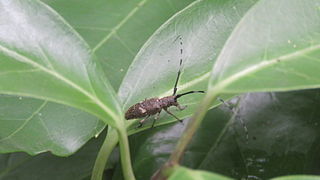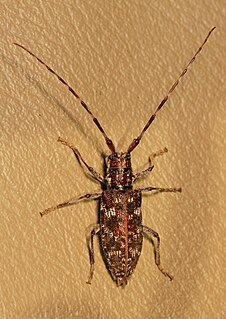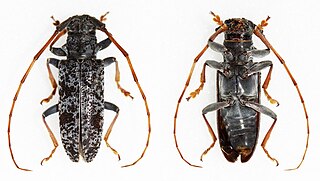Amerika Samoa is the regional anthem of American Samoa. Composed by Napoleon Andrew Tuiteleleapaga and written by Mariota Tiumalu Tuiasosopo, it was officially adopted in 1950.
Omia is a district of the province of Rodríguez de Mendoza in Peru.
Online Mendelian Inheritance in Animals (OMIA) is an online database of genes, inherited disorders and traits in more than 135 animal species. It is modelled on, and is complementary to, Online Mendelian Inheritance in Man (OMIM). It aims to provide a publicly accessible catalogue of all animal phenes, excluding those in human and mouse, for which species specific resources are already available. Authored by Professor Frank Nicholas of the University of Sydney, with some contribution from colleagues, the database contains textual information and references as well as links to relevant PubMed and Gene records at the NCBI.

Monochamus is a genus of longhorn beetles found throughout the world. They are commonly known as sawyer beetles or sawyers, as their larvae bore into dead or dying trees, especially conifers such as pines. They are the type genus of the Monochamini, a tribe in the huge long-horned beetle subfamily Lamiinae, but typically included in the Lamiini today.

Synodontis omias is a species of upside-down catfish native to the Niger River basin of Guinea, Mali, Niger and Nigeria. It was first described by German-born British zoologist, ichthyologist, and herpetologist Albert Günther in 1864, from a specimen collected in Jebba, Nigeria, on the Niger River. There have been very few specimens of this species identified, and it may be the same species as S. budgetti from the Upper Niger.
Omia is a genus of moths of the family Noctuidae.

Monochamus scutellatus, commonly known as the white-spotted sawyer or spruce sawyer or spruce bug, is a common wood-boring beetle found throughout North America. It is a species native to North America.

Monochamus dubius is a species of beetle in the family Cerambycidae. It was described by Charles Joseph Gahan in 1894. It is known from India, Thailand, Myanmar, Vietnam, Taiwan, and China.

Monochamus subfasciatus is a species of beetle in the family Cerambycidae. It was described by Henry Walter Bates in 1873. It is recorded from Japan where it infests Japanese red pine and is a vector of the nematode Bursaphelenchus doui.
Monochamus adamitus is a species of beetle in the family Cerambycidae. It was described by James Thomson in 1857. It is known from Tanzania, Sierra Leone, Angola, Ghana, Mozambique, the Ivory Coast, Senegal, the Democratic Republic of the Congo, Malawi, and Zimbabwe.

Monochamus clamator, the spotted pine sawyer, is a species of beetle in the family Cerambycidae. It was described by John Lawrence LeConte in 1852.

Monochamus galloprovincialis, the pine sawyer beetle, also referred to as the black pine sawyer beetle, is a species of beetle in the family Cerambycidae. It was described by Olivier in 1795, originally under the genus Cerambyx. It has a wide distribution, occurring naturally throughout Europe and the Caucasus. It has also been introduced into the Canary Islands. It serves as a vector for the parasitic nematode species Bursaphelenchus xylophilus, and also acts as a host to the parasitoid wasp species Dolichomitus tuberculatus.

Monochamus irrorator is a species of beetle in the family Cerambycidae. It was described by Chevrolat in 1855, originally spelled as "Monohammus" irrorator. It is known from the Republic of the Congo and Nigeria.
Monochamus leuconotus is a species of beetle in the family Cerambycidae. It was described by Francis Polkinghorne Pascoe in 1869, originally under the genus Anthores. It is known from Tanzania, Cameroon, Malawi, Kenya, Mozambique, Namibia, South Africa, Uganda, the Democratic Republic of the Congo, Zambia, Angola, and Zimbabwe. It feeds on Coffea arabica.

Monochamus maculosus, the spotted pine sawyer, is a species of beetle in the family Cerambycidae. It is known from Canada and the United States, and was formerly known as Monochamus mutator.
Monochamus ruspator is a species of beetle in the family Cerambycidae. It was described by Johan Christian Fabricius in 1781, originally under the genus Lamia. It has a wide distribution throughout Africa.
Pallavolo Cisterna 88 is an Italian women's volleyball club based in Cisterna di Latina and currently playing in the Serie C.
Omias saccatus, the sagebrush weevil, is a species of broad-nosed weevil in the beetle family Curculionidae. It is found in North America.
Omias is a genus of broad-nosed weevils in the beetle family Curculionidae. There are more than 50 described species in Omias.








